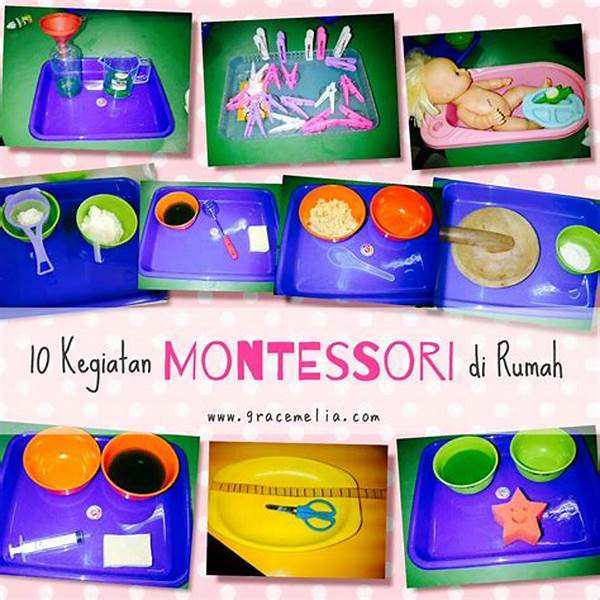Kegiatan Montessori: Nurturing Young Minds
In a world where education is constantly evolving, the Montessori method stands out as a beacon of innovation and child-centric learning. Imagine an environment where the child’s curiosity is not just encouraged but celebrated. The heart of the Montessori philosophy is the belief that children learn best when they are actively involved in their own learning journey. Unlike traditional educational methods that rely heavily on rote memorization, Montessori emphasizes hands-on learning and practical life skills.
Read More : Hands-on Learning Benefits In Montessori Method
Dr. Maria Montessori, the founder of this educational approach, developed the method in the early 1900s after observing how children learn in a natural setting. Her observations led to the creation of the Montessori environment—a unique space where children have the liberty to choose activities that interest them. This setting, often called the “prepared environment,” includes various educational materials designed to stimulate learning in diverse areas such as math, language, sensory perception, and cultural studies.
Montessori has gained international acclaim, with devoted followers attesting to its effectiveness in cultivating independent and self-motivated learners. Parents and educators alike are drawn to the method for its emphasis on child-led exploration and discovery. The goal is not just to fill the student with information but to ignite a passion for lifelong learning.
Many people wonder how activities—referred to as kegiatan Montessori—are structured. The answer is simple yet profound: Montessori activities are designed to support natural development. Through structured play, children learn by doing, focusing on activities that develop fine motor skills, critical thinking, and social cooperation. These tasks are presented with intention and precision, making sure they are within the reach of the child’s capabilities yet challenging enough to encourage growth.
The testimonials speak for themselves. Parents and students alike share stories of transformations, where once shy children blossom into confident learners. The Montessori method’s impact transcends academic achievement; it fosters emotional intelligence, creativity, and resilience—attributes that are crucial in today’s volatile world.
The Benefits of Kegiatan Montessori
Recent research has shown that early exposure to Montessori can have lasting benefits. Studies highlight that children who participate in Montessori environments often outperform their peers in traditional schools in areas such as math and reading. But it’s not just academics where Montessori shines. Emotional and social development is another area where kegiatan Montessori plays a critical role. Children learn empathy, collaboration, and communication skills through peer interaction and group activities.
As a parent or educator, you might ask, “How can I incorporate Montessori principles into my child’s life?” The answer lies in adopting its core tenets—promoting independence, respecting the child’s choices, and providing learning tools that stimulate inquiry and exploration. Montessori isn’t just an educational approach; it’s a lifestyle.
How Kegiatan Montessori Transforms Learning
When you walk into a Montessori classroom, the first thing you notice is the autonomy given to children. There’s no teacher dictating what needs to be learned next; instead, the child is the master of their own learning path. This is where the magic of kegiatan Montessori shines, as it empowers children to make decisions about what they want to explore. By engaging in activities such as practical life tasks, sensorial exercises, and language arts, children develop a profound understanding of the world around them.
The layout of a Montessori classroom is meticulously planned to facilitate independent learning and exploration. Materials are accessible, inviting, and specifically designed to teach a single concept or skill. This ensures that a child is not overwhelmed but rather empowered to dig deeper into their own areas of interest. Montessori educators are trained to observe rather than intervene, guiding only when necessary, which strengthens a child’s capacity to problem-solve independently.
Discussion Points on Kegiatan Montessori
Implementing Kegiatan Montessori at Home
Bringing Montessori into your home doesn’t require a complete overhaul of your educational philosophies. Instead, it involves making mindful decisions about how your child interacts with their environment. Start by organizing their play area to promote independence: use low shelves for toys and educational materials, and ensure they have easy access to learning tools.
One of the simplest ways to adopt Montessori principles at home is through everyday tasks. Encourage children to participate in cooking, cleaning, or gardening, activities that naturally cultivate practical life skills. These real-world applications are at the heart of kegiatan Montessori, as they help children gain confidence in their abilities.
In conclusion, kegiatan Montessori offers a compelling blend of freedom and structured learning, uniquely positioning it to nurture well-rounded, curious, and resilient children ready to tackle the challenges of the future. Whether through formal schooling or home activities, the Montessori approach provides children the tools they need to navigate the complexities of the modern world with confidence and curiosity.
